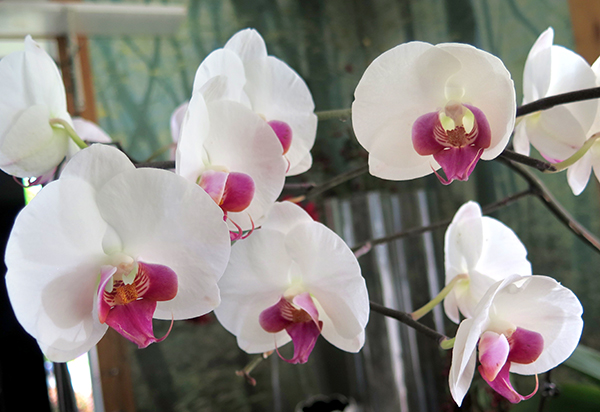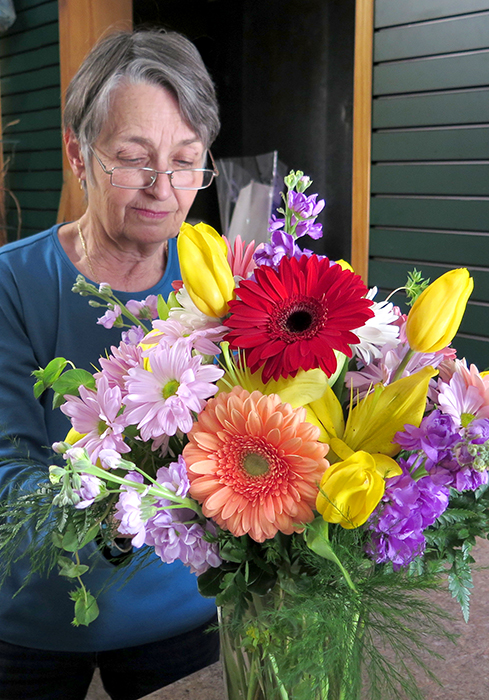Let’s be honest. Some holidays probably don’t merit any ink on the calendar (no offense to Fruitcake Toss Day, which is completely real, and does sound fun). However, a holiday most of us can get behind, as we were all brought here by one, is Mother’s Day. Yet, how do we step up to the occasion of such a weighted holiday? How do we give a gift that can match the magnitude of a mom?
Well, we can’t — but flowers aren’t a bad attempt. Flowers have been a popular way to thank our mothers since early in the holiday’s inception, with close to $2.5 billion spent on flowers each year.

Writer Jared Posey says that while box stores may be cheaper, you often don’t get lasting blooms, like you would at a florist, such as White Orchid Distinctive Floral Studio. | Limestone Post
Cut flowers, flower arrangements, and living plants are all time-honored ways to show your love. But where you shop and what you buy can translate into very different gifts, with very different consequences — for the local economy, the environment, or even what your gift will look like the day after this special holiday.
Where to go
It’s not hard to find flowers for sale — big-box stores, local flower shops, supermarkets, nurseries, the internet, and even the gas station will all have blooms for sale around Mother’s Day. But so many options can lead to confusion— just as when we stand in front of three neighboring coffee shops, trying to choose one.
As with any shopping decision, it depends on what your priorities are. If cost is your only concern, it’ll be hard to beat the megastores, which are able to purchase select varieties at a bulk price. They get a discount and so does the consumer, but that lower price decreases the level of care given to each plant. As Jesse Kennedy, of Bloomington Valley Nursery, says, “Box stores are mostly water-and-go. At a nursery there’s excess care, so you’re paying for the quality of the plant.”
The expertise, care, and plant diversity at a nursery or florist shop generally leads to healthier, better-looking, longer-lasting plants and flowers. We try hard to escape it, but you often get what you pay for. Furthermore, when you support small businesses, that money is more likely to stay in the community.
What to look for
Wherever you decide to go, this general advice should help you find the right flowers or plant:
- Is the store well-kept and the plants well-cared for? If the plants or plant area looks forgotten, go elsewhere.
- What are the flowers doing? Full blooms may look nice the moment you buy them but may pass their peak by the time you give the gift. Look for well-rooted plants or buds that are still opening. Ask a staff member to let you see the roots. That way, the staff can do so delicately.
- What do the roots say? If they’re overly rootbound, with thick roots curling round and round or cracking through the bottom, the plant may have been stunted. If the roots are weak and crumbly, this plant will likely struggle.
- What do the leaves tell you? Leaves are a better indicator than flowers for plant health. Yellow, brown, or droopy leaves are bad signs. Look for vibrant, green foliage.
- Do the plants have leggy stems or spindly foliage? This is a symptom of insufficient light, and means unhealthy, poorly rooted plants. Instead, look for plants with bushy, robust growth.
Arranging for an arrangement
The Bloomington Community Farmers’ Market is a great way to shop for arrangements locally. Look for vendors such as Linda Chapman of Harvest Moon Flower Farm. A hard winter will mean fewer varieties made it to spring, but Chapman says she’s still expecting plenty of locally grown tulips, poppies, and ranunculus, among others, by Mother’s Day.
If ordering for Mom from a distance, it may be tempting to go online and click to order. However, the amount of comical “ordered vs. delivered” photos from clients of these large flower websites may dissuade you. If you want to ensure the right gift is delivered, work with a local florist near Mom.

White Orchid’s Joanne Figuered says there is no etiquette in arrangements, so don’t worry about which flowers go together: “Flowers are personal.” | Limestone Post
But what do you look for in a floral arrangement? Joanne Figuered at White Orchid Distinctive Floral Studio says, “There is no etiquette in arrangements. Don’t worry about ‘what’s right’ or ‘what goes together.’ Flowers are personal.” So look for something that speaks to you, or to the person you’re hoping to honor.
At the end of the day, it’s not about the gift, but the giving. The meaning we put into thinking about and putting together these gifts is directly felt by those we give to. Figuered often has customers coming into her shop looking for the right formula. What flowers are supposed to look good? What am I supposed to say on the card?
Three simple flowers or three little words simply put, coming from your own heart and brain, your own intentions and feelings, will mean more than an acre of roses to the mother you hope to honor this year.
Make it special
As with many things, be creative. You could tap into a specific color or flower you know Mom likes. You could pick a bouquet of wildflowers from the backyard. Rather than shopping for arrangements, go into a flower shop and have the florist help you make your own.
Write a letter or craft your own card to personalize your gift. Think Hallmark is a better writer than you? Not a chance. Only you know how you feel about this mother. Think about the time you’ve shared with this person. Is there a moment that will never leave you? Weave that into your gift and tell them about it.
After all, Mother’s Day is not Mothers’ Day. The creator of the holiday, Anna Jarvis, specifically wanted the apostrophe before the “s.” This was so each person could think exactly of their mother, or the mother of their children. So, while we celebrate all mothers, only you can create a moment between yourself and the mothers in your life.
So, sure, give them a gift. But also give them the gift of yourself. For that’s what the finest mothers do: They give themselves selflessly, tirelessly, relentlessly. This second Sunday in May, and any other day the sun rises, let’s cherish them.


